Have you ever skipped what you thought were a few ‘minor’ steps in the Ikea instruction manual, just to realize an hour later that you missed one of the most critical pieces? (and now you have to disassemble the whole thing!) I have little patience for these instruction manuals and I do this almost every time I set something up. It drives me crazy.
Implementing marketing automation in your business can be a similar process. I’ve worked with several businesses who wanted to skip the foundational pieces and get right into all the cool features of their new tool. They spend an afternoon whiteboarding an entire process that’s almost impossible to implement correctly the first time. They over-engineer it because hey, now they have the tool that can finally do everything they wanted.
Sound familiar?
While this is a great exercise, a marketing automation strategy needs to be broken down into simpler sub-systems to get right. To correctly implement your marketing automation tool, you need to launch in structured phases that build on one another, just like you build a foundation and footing on your home before you can frame or roof it.
Below you’ll find a pyramid similar to Maslow’s hierarchy of needs. Just like Maslow’s theory, these are building blocks that build on one another. In most cases, you won’t be able to implement one without first doing the previous one.
5 Building Blocks for Succeeding with Marketing Automation
- Strategy – Marketing automation should be integrated into the overall marketing strategy of the business.
- Follow Up – Start with basic follow up systems in your marketing. It sounds boring, but it’s an important first-step tactic to get your feet wet.
- Qualify Prospects – Use marketing automation to tell you who’s more likely to do business with you.
- Scale Personal Attention – Use marketing automation to scale real human interaction with customers and prospects.
- Systematize, measure and improve – Set goals and benchmarks to continually improve.
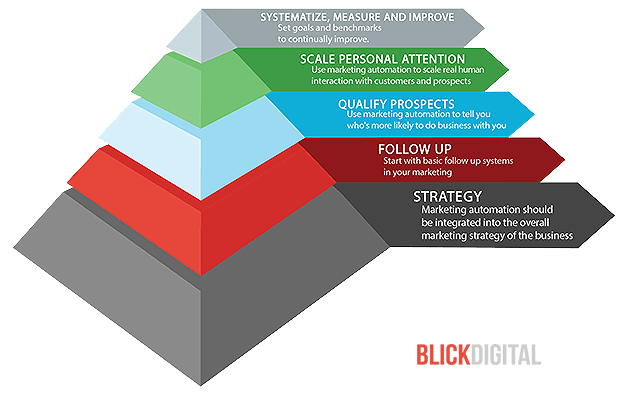
Strategy
Marketing automation tools like Infusionsoft have a unique ability to augment a business’s success or failure. If your marketing strategy is well aligned and effective, then you’ll find that marketing automation can drastically help improve your efforts and you’ll see an amazing ROI. On the other hand, if your marketing strategy is unorganized, you’ll find that implementing marketing automation can really distract your business.
There’s no silver bullet here, but don’t skip this step! This is the step that will provide the most benefit for your marketing automation tool in the long run.
Follow- up
This one is straight forward and where marketing automation has its roots. THIS is where you start if you’ve never used marketing automation before. At the very foundation of any marketing and sales efforts, you’ll have some sort of follow-up in place. For example, you meet someone at an event, you follow up. Someone requests information from your website, you follow up. Someone calls into your office, you follow up.
Now that you have an automation tool, you’re able to follow up consistently. Where you were dropping the ball before, now prospects and customers are getting consistent communication from you. Below you’ll find an example of a client who has built an entire years worth of follow up content for prospects requesting information from his website. I love this because it’s simple and took him an afternoon to collate the marketing assets he already had in his business to build this process.
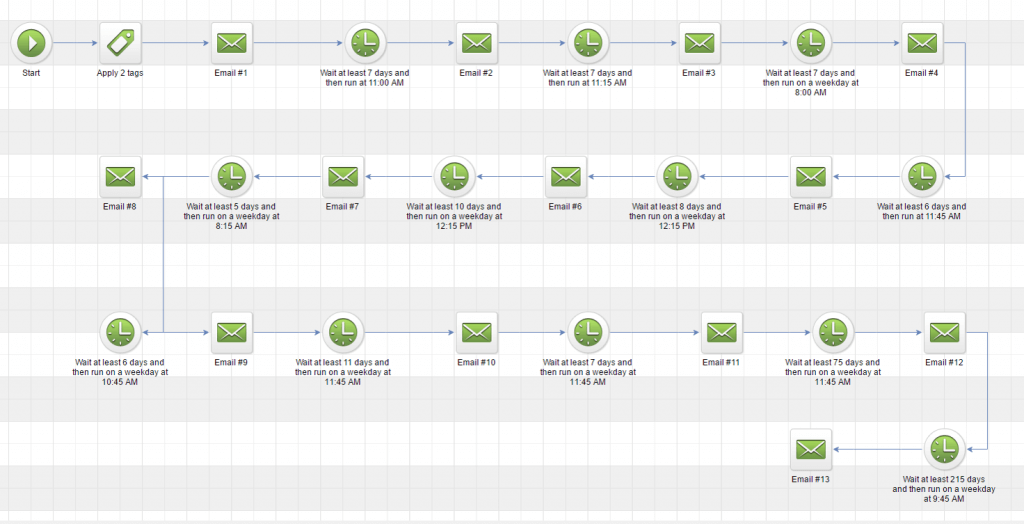
There’s also something about knowing your prospects are getting attention from you without you lifting a finger. Here’s a screenshot of my Infusionsoft dashboard and what I wake up to on a daily basis. These are real people getting followed up with because I’ve taken time to build the appropriate systems.
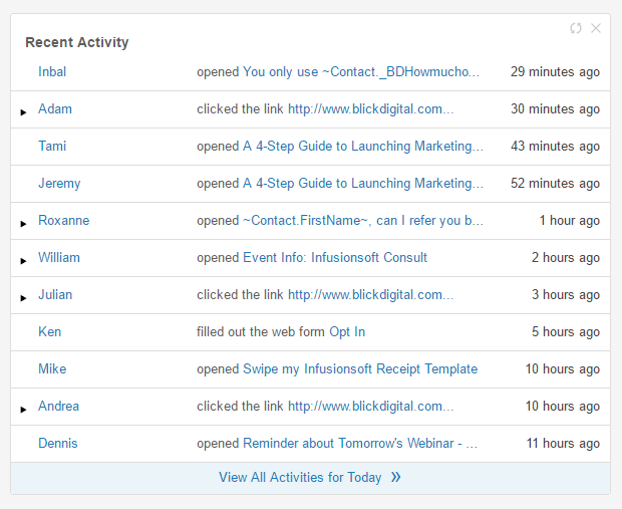
Qualify Prospects
In this stage, you’ll take follow up to a new level. Using your follow-up machine, send information and videos to your prospects about whom you work best with. I’ve seen this really well executed where sales happen over the phone. Using your automated follow up, you can send video before appointments to introduce the rep and let the customer know what they can expect. If they don’t take action after watching your video, you’ll know the lead isn’t as qualified as those who do.
There are plenty of examples here, but the main thing is that your tool wisely to make sure you only spend time with only those that are ready to be spoken with.
Here’s another more automated way of using Infusionsoft to qualify prospects:
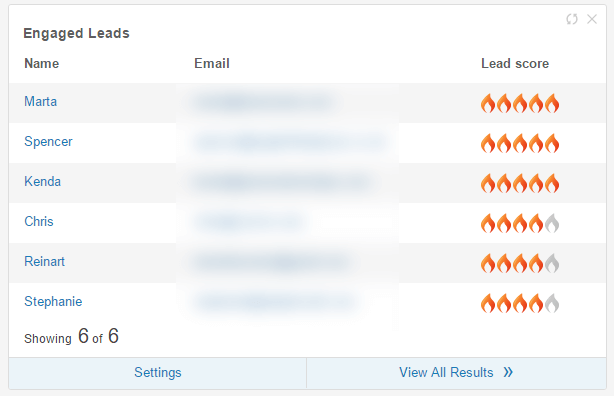
Scale personal attention
This is the step where we separate the boys from the men. I can’t take credit for this term though, I first heard it from Jermaine Griggs. He defines this step as “using technology to scale what appears to be real, human interaction.”
Once you have a steady stream of leads and prospects, use your marketing automation tool to ask prospects specific and actionable questions that allow you to follow up in ways that are meaningful to them. You probably already have these questions customer avatars or sales scripts, but use marketing automation to your advantage in these instances.
If you’ve opted into my list, you’ll have seen this in action. I ask everyone what percentage of Infusionsoft they think they’re using.
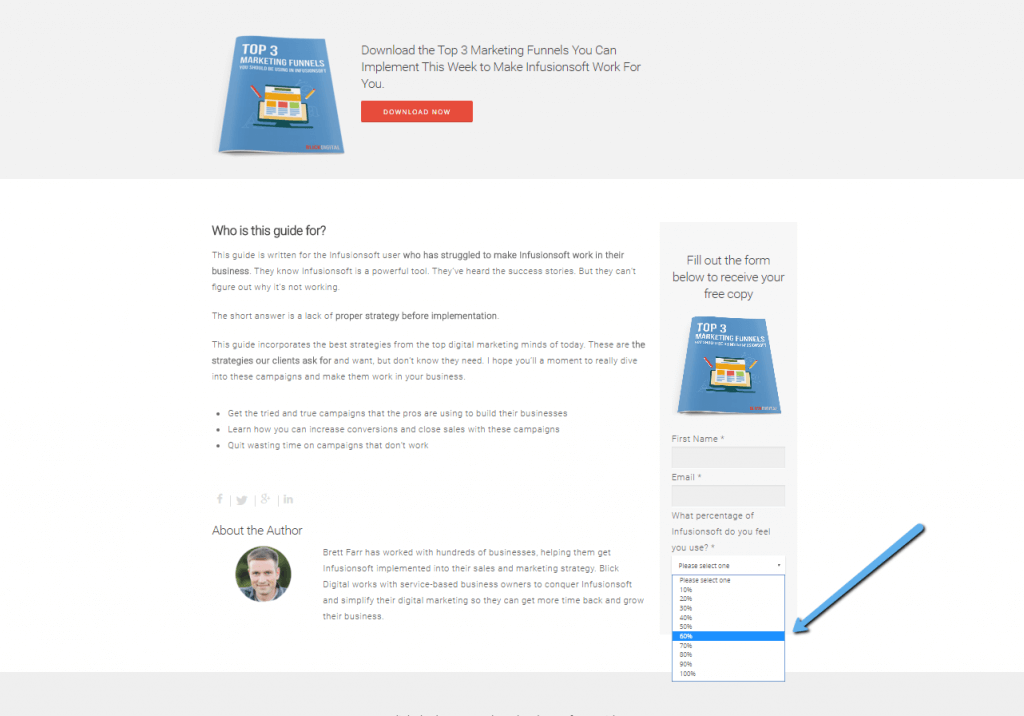
(Request the guide here)
If you’re using 70, 80, 90 or 100% of Infusionsoft, you’re probably not my target market and I’ll let you know that. Instead, I’ll ask if we can be referral partners of one another. On the other hand, if you’re using less than 70% of Infusionsoft, you’ll get a nicely crafted message from me pointing out the fact that you’re not using this powerful tool to its full potential.
These are just a few examples, but this is really where you’ll begin to notice how effective marketing automation can be in your business.
Systematize, measure and improve
Using the steps above, you can use your marketing automation tool to design intentional and repeatable experiences for your prospects and customers. Shout out to Greg Jenkins for that nugget.
An often overlooked benefit of implementing marketing automation is that it forces you to think about the customer journey and all the steps involved. Even if you don’t implement marketing automation in your business, it’s a worthwhile exercise to design your marketing in a systematic way so that you’re able to measure over time and then improve.
After you’ve started to correctly execute the first 3 steps, take time to track what works well and what doesn’t. Marketing automation is a system and any system should be constantly evolving and improving or it will eventually become tired or irrelevant.
Don’t skip any steps in this process and don’t over-engineer it or just like the Ikea manual, you’ll end up coming back and re-working your marketing automation plan. Or you’ll end up paying someone like me to fix it ;).
What do you think? What has your experience been like implementing Infusionsoft or another marketing automation tool? Leave your comments below.

